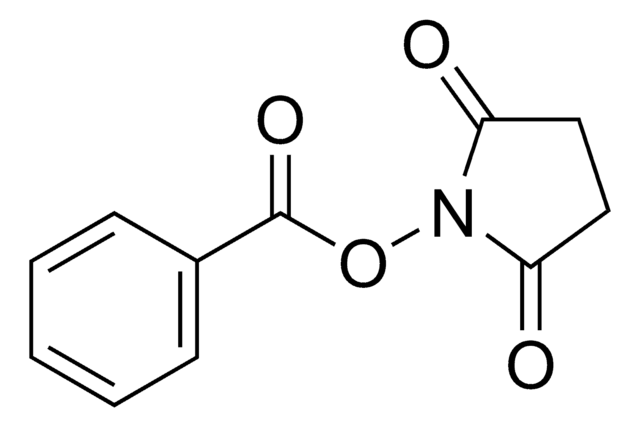457078
1-Pyrenbuttersäure-N-hydroxysuccinimidester
95%
Synonym(e):
N-Hydroxysuccinimidyl Pyrenebutanoate; 2,5-Dioxopyrrolidin-1-yl 4-(pyren-1-yl)butanoate
About This Item
Empfohlene Produkte
Qualitätsniveau
Assay
95%
Form
powder, crystals or chunks
Zusammensetzung
Carbon: 70.7-78.9%
Farbe
faint beige
mp (Schmelzpunkt)
132-136 °C (lit.)
Anwendung(en)
diagnostic assay manufacturing
hematology
histology
Lagertemp.
room temp
SMILES String
O=C(CCCc1ccc2ccc3cccc4ccc1c2c34)ON5C(=O)CCC5=O
InChI
1S/C24H19NO4/c26-20-13-14-21(27)25(20)29-22(28)6-2-3-15-7-8-18-10-9-16-4-1-5-17-11-12-19(15)24(18)23(16)17/h1,4-5,7-12H,2-3,6,13-14H2
InChIKey
YBNMDCCMCLUHBL-UHFFFAOYSA-N
Allgemeine Beschreibung
Anwendung
Sonstige Hinweise
Signalwort
Warning
H-Sätze
Gefahreneinstufungen
Eye Irrit. 2 - Skin Irrit. 2 - STOT SE 3
Zielorgane
Respiratory system
Lagerklassenschlüssel
11 - Combustible Solids
WGK
WGK 3
Flammpunkt (°F)
Not applicable
Flammpunkt (°C)
Not applicable
Persönliche Schutzausrüstung
dust mask type N95 (US), Eyeshields, Gloves
Choose from one of the most recent versions:
Besitzen Sie dieses Produkt bereits?
In der Dokumentenbibliothek finden Sie die Dokumentation zu den Produkten, die Sie kürzlich erworben haben.
Kunden haben sich ebenfalls angesehen
Unser Team von Wissenschaftlern verfügt über Erfahrung in allen Forschungsbereichen einschließlich Life Science, Materialwissenschaften, chemischer Synthese, Chromatographie, Analytik und vielen mehr..
Setzen Sie sich mit dem technischen Dienst in Verbindung.











